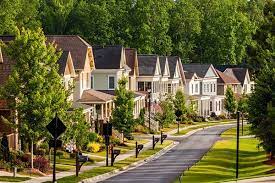The majority of residential areas aren’t overly complicated. A home builder purchases a piece of property divides it into buildable lots and constructs roads, utilities, and other infrastructure. Then they construct houses and sell them to potential purchasers. There might be some recreational facilities, like walking trails, ponds, or a community pool, but that’s about it. Master-planned communities, or MPC, are completely another animal. These are residential communities, yet they resemble small towns more than the subdivisions that most homebuilders produce. Here’s a rundown of what a master-planned community is, why they’re good investments, some examples of real-world PCs, and how to invest in PCs through the stock market.
Planned Communities
A master-planned community (MPC) is a big, carefully planned residential area. MPCs are generally self-contained mini-cities with commercial assets and significant recreational, educational, and other amenities, in contrast to most residential developments. An MPC can range in size from 10,000 acres (15.6 square miles) to tens of thousands of acres (15.6 square miles).
Golf courses, pools, walking trails, and lakes are common recreational features in master-planned communities. They frequently have their own school districts, shopping and commercial districts, and other amenities that you’d find in a regular suburban town.
Many MPCs are in close proximity to large cities. Summerlin, for example, is a master-planned city located in Las Vegas, Nevada.
The main concept of an what is Master-planned community is that a developer will buy a large plot of land and sell it to residential or commercial developers over time, allowing the community to grow. In the next section, we’ll look at a real-world example of a master-planned neighborhood.
People may opt to live in an MPC for a variety of reasons. Because master-planned communities are frequently self-contained in terms of commercial amenities, homeowners often have everything they need within a few minutes drive of their houses. MPCs are intended to be areas where residents may live, work, and shop without having to leave the neighborhood.
Master-planned community example
There are many master-planned communities located throughout the world, including in many urban and suburban areas in the U.S. Some of them include:
#1. The Woodlands
in the Houston metropolitan area: The Woodlands, a 27,000-acre community in Houston, was built in 1974 to suit the city’s rising population. Six championship golf courses, a 200-acre lake, 100 miles of trails, 80 parks, a 17,000-seat amphitheater, a huge shopping mall, a conference center, and many more attractions may be found there today.
#2. The Villages
The Villages is an “active adult retirement community” in Central Florida that only admits inhabitants over the age of 55. Golf, tennis, town squares, shops, fitness facilities, restaurants, entertainment venues, pools, social clubs, and other amenities are available.
#3. Savannah Quarters
Savannah Quarters is a collection of distinct residential districts divided by rivers, parks, and green areas in Savannah, Georgia. There are golf courses, tennis courts, parks, a spa, and a fitness facility, as well as a commercial section.
Are you considering purchasing a new home in a master-planned community? Calculate your mortgage payment with Bankrate’s mortgage calculator.
What is Community Project Planning?
Community development planning consists of a public participatory and usually interactive form of town or neighborhood planning and design in which diverse community members (often termed “stakeholders”) contribute toward the formulation of the goals, objectives, planning, fund/resource identification, and direction, planned project implementations and reevaluation of documented local planning policy. It is a logical “bottom-up” evolution of (formerly “top-down”) regional, city, and urban planning in an era of plateaued or diminishing public resources, increasing local burdens, and responsibilities, and public activism. It often promotes public/private partnerships as a means to harness physical development activities in support of community-defined goals.
History of planned communities
Riverside, the first planned community in the United States, is located west of Chicago in the suburbs. The town was founded in 1869 by landscape architects Frederick Law Olmsted and Calvert Vaux, who also cooperated on the construction of Central Park in New York City.
Before beginning construction on Riverside, Olmsted and Vaux spent two years planning the layout: a suburban neighborhood with a focus on convenience, attractive flora, and recreational space. They devised a layout that pushed buildings back from major thoroughfares and built lovely, gently curving roadways that weaved their way through trees and vegetation.
Riverside was named a National Planning Landmark in 1991. Several structures in Riverside have been designated as National Historic Landmarks, including the Avery Coonley House and the F. F. Tomek House.
Riverside is a sophisticated, opulent Chicago neighborhood that is as popular as ever, with more than 8,800 residents. It spans 1600 acres and features gas-lit street lighting as well as a variety of dwelling styles ranging from lovely cottages to opulent Victorian palaces.
Riverside’s success was simply the beginning of planned communities, according to Olmsted and Vaux. At the turn of the century, an increasing number of architects drew inspiration from Riverside’s design, and planned communities sprouted up across the country one after the other.
Planned communities today
It’s rare to find two planned communities that are identical; amenities, home costs, dues owed, and lifestyle can all differ significantly. While some neighborhoods have a more typical neighborhood feel, others have a plethora of activities to keep the entire family occupied.
For example, Eastmark, a 3,200-acre best-selling master-planned community in Mesa, Arizona, loves to provide its inhabitants with a little bit of everything. An organic commercial farm, award-winning private schools, and a local cafe are just a few of its notable attractions. Eastmark also intends to add a large disk golf course, a skate park, and a catch-and-release fishing pond in the near future.
Ken Noland, Eastmark’s community representative, says, “We really have a multiplicity of opportunities. Through our community living teams, we generate opportunities. We assist anyone who wishes to start a basketball club, and eventually, residents take over.”
There are also park concerts, food trucks, and other seasonal celebrations to bring the community together in the spring.
Eastmark now has over 15,000 residential units available, thus with new-build townhomes beginning in the high $200,000s and single-family homes beginning in the low $400,000s. When it comes to buying, Noland says buyers should be aware that their market has been “on fire” since early 2020.
Benefits of planned communities
#1. Less traffic and clever road planning
Gated entries are common in planned communities, reducing and limiting traffic to just residents and their guests. In fact, traffic flow and road system planning are careful considerations in order to avoid backups and traffic bottlenecks.
#2. Walkable layout and easy access to public transportation
The infrastructure of a planned community must prioritize convenience and walkability. In fact, to create a truly urban environment, residential neighborhoods are within walking distance of stores, businesses, and other community amenities. Another crucial component for long-term success is location. Additionally, communities are located in desirable areas near large cities and public transportation for convenient commuting.
#3. Amenities for all
Amenities are one of the big-ticket items that draw residents. Today, many communities offer a variety of:
- Parks
- Clubhouses
- Shopping centers
- Restaurants
- Lakes
- Pools
- Golf courses
- Bowling alleys
- Fitness centers
- Tennis Courts
- Pickleball
#4. Green Space
Green space preservation contributes to the beauty and tranquility of neighborhoods, and it’s a top consideration for many buyers. Therefore, nearby woodland areas will include trail systems, bike paths, parks, sports fields, trees, and flowers. Also, scenic greenery along street fronts for residents to enjoy.
#5. Community and Events
If you enjoy the notion of living in a neighborhood with a strong sense of community, then a planned community is the place for you! The communal atmosphere provides plenty of opportunity for enjoyable, pleasant interaction with neighbors, with shared amenities and regularly organized events for residents of all ages.
#6. Flexibility in Home Choices
Homes produced by a variety of builders are common in planned communities. As a result, a wide range of residences and floor layouts are available at various price points.
#7. Safety and Security
When it comes to buying a new house, one of the most important considerations for families with small children is the safety of their children. Many planned communities have gated entrances and local watch organizations, and some even have 24-hour patrols to provide much-needed peace of mind.
Challenges of planned communities
#1. Less privacy
The dense population, closer housing proximity, thus communal ambiance of planned community living are unlikely to appeal to those who value their privacy and space.
#2. Community development district
A Community Development District (CDD) is a governing body inside a community that is in charge of general maintenance. Consequently, whereas a Homeowners Association (HOA) is in charge of enforcing rules and regulations in order to keep houses and neighborhoods in good repair. Additional fees (sometimes called dues) can be to buyers, ranging from hundreds to thousands of dollars per year.
Although it is customary to have at least one of these governing bodies in existence, not all communities have both CDD and HOAs. Buyers should anticipate paying some type of dues, whether monthly, quarterly or annually, in all planned communities.
Aside from the additional cost, the restrictions that come with such governing organizations can be a genuine problem for some homeowners. Therefore, their guidelines frequently include restrictions on landscape types, paint colors, and holiday decorations.
#3. Extra fees
Homeowners in planned communities are required to pay additional fees for the extra amenities they give. Thus, the amount owing varies depending on the community’s offers. Similarly, Peirce describes how his neighborhood recently completed a capital reserve assessment in which engineers evaluated and predicted “improvements needed” over the next 20 to 30 years.
“Most of these communities will charge an initiation fee and a capital reserve cost,” Peirce adds. “And that’s to build up the capital reserve, which will cover when they need to make capital projects like paving or repairing sidewalks.”
What was the First Planned Town in America?
- Savannah
Savannah is recognized as the first planned city in the United States. Oglethorpe designed the layout of the city as a series of grids, which allowed for wide open avenues to be interlaced with shaded public squares and parks that functioned as town meeting places and centers of business. Oglethorpe’s plan for the city was ultimately successful. The city of Savannah was originally divided into 24 squares, but only 22 of those squares remain today.
What is the Largest Planned Community in the United States?
Within The Woodlands’ 151 parks, 220 miles of hiking and biking paths, and forest preserves, an astonishing 28% of the town has been designated as green space. The Woodlands is a 28,500-acre master-planned neighborhood. Niche has recently announced that for the second year in a row, they have named The Woodlands as the best community in the United States to live in.
How Do Master-Planned Communities Make Money?
The developer of the MPC purchases thousands of acres of uninhabited land that can be utilized. In the first stages of the project, the developer will sell a portion of the property to homebuilders, who would then construct residential subdivisions. The demand for commercial real estate is increased as a result of these neighborhoods.
Tips for Buying in a Planned Community
Do you think the planned community living sounds appealing? One piece of advice Peirce gives to potential buyers is to do your homework hence, on the community first and visit with the general manager or a member of the sales staff to acquire all the details on what you’re getting for your money.
“One thing buyers may not realize when they enter a planned community is that all of the infrastructure. Additionally, everything created within that community is the community’s responsibility.”
Peirce goes on to say that compared to regular neighborhoods, planned communities often come with unexpected costs.
“The last thing you want to do is buy in one of these communities and then find out you have an assessment you didn’t know about,” he says. “For example, one of my buyer’s agents is putting an offer on a community right now, and this community has a $20,000 assessment for club renovations.”
According to Peirce, this initially indicates that if the buyer closes on the property. Also, they will be responsible for a share of the increased assessment payments. It’s a useful detail to be aware of.
How to Invest in Master-Planned Communities
There are a few publicly traded corporations with master-planned community activities. Brookfield Property Partners (NYSE: BPY) and D.R. Horton (NYSE: DHI), for example, both have MPCs that are among the best-selling in the country.
Neither of these, however, is a straight play on the MPC business. D.R. Horton is primarily a homebuilder, while Brookfield owns and operates a diverse portfolio of real estate assets.
Howard Hughes Corporation, whose master-planned communities I mentioned as examples in the preceding section, is almost entirely focused on the master-planned community business as a pure play. The Woodlands, Woodlands Hills, and Bridgeland, all in Houston; Summerlin, near Las Vegas; Columbia, in Maryland (between Washington, D.C., and Baltimore); and Ward Village, in Hawaii are its six-core neighborhoods.
With several decades of runway ahead of it, the corporation takes an extremely long-term approach to creating shareholder wealth through its MPCs. I already indicated that the Bridgeland neighborhood hasn’t even reached one-sixth of its planned population, and Summerlin has room for almost 100,000 more people. Those communities were the 12th and 3rd best-selling MPCs in the United States in 2019.
Each MPC has its own K–12 education system, police and fire departments, as well as shopping and food options. It’s easy to see why the company’s business model has been compared to the video game classic Sim City in real life.
What are the keys to Successful Community Planning?
Planning, collaboration, and education are typically at the core of community conservation efforts that are realized with the greatest level of success. Learn how to initiate a project and track its development from the beginning to the end of it. It is essential to have a clear understanding of the prerequisites that must be met in order for community conservation efforts to be successful before beginning any endeavor.
Why are There So Many Brick Houses in Texas?
The cause has to do with the location and the geology of the area. Clay is abundant in our soil, which is not ideal for gardening but works quite well for the production of bricks, as any gardener can tell you. Clay can be found in considerable quantities all the way through the United States, starting in the middle of Texas, passing through Oklahoma and Arkansas, and continuing on into Virginia and Maryland.
What are the Fastest Growing Master Planned Communities?
With 4,004 sales, the Active Adult community of The Villages in Central Florida has emerged as the year’s most successful real estate venture. With 2,574 sales, Lakewood Ranch in Sarasota has reclaimed its position as the best-selling all-ages community in the whole country. Summerlin, which is located in Las Vegas, Nevada, has secured the third-place rating with 1,619 sales.
FAQ
Which is a planned city?
A planned community, planned city, or planned town is any community that was carefully planned from its inception and is typically constructed on previously undeveloped land. This contrasts with settlements that evolve in a more ad hoc and organic fashion.
Which of the following is planned towns?
A few well-known well-planned cities of India are Dholera, Naya Raipur, Panchkula, Mohali, Dhule, Bhilai, Auroville, Sector 62 Noida, Bhubaneswar, Secunderabad, Dispur, Cooch Behar, Jamalpur, Solan, Nahan, Kaushambi, and other least known planned cities of Himachal Pradesh.
Is Chandigarh a planned city?
Chandigarh was India’s first planned city. Designed by the Swiss-French architect Le Corbusier, it was commissioned in 1950 by India’s first post-Independence Prime Minister, Jawaharlal Nehru.






